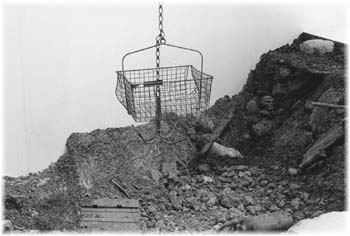Color as Concept
African American artists treat 'black' as a verb at WORKS
By Ann Elliott Sherman
THE NEW SHOW Black Is a Verb! at WORKS/San José is a deliberately mixed bag, intended by guest curator Kira Lynn Harris to demonstrate that cultural history and issues of "outsider" racial identity are not the end-all and be-all for every African American artist but can serve as a starting point for other, primarily aesthetic and conceptual, explorations. Key among these is the use of the color/racial category "black" as a metaphor.
Featuring just six Southern California artists in the white expanse of the gallery, the resulting show has the spare, at-arm's-length quality often associated with conceptually oriented art. Even the most ironic, colorful or dreamy pieces take a cool, formal approach. In such shrewdly knowing company, the exclamatory exhibition title seems an archly ironic throwback to those straitjacketing notions of the artist as activist that the show hopes to push beyond.
No marginalized group wants to be confined to a time-warped ghetto of creative expectations, but the edge and energy sparked by a sense of otherness here seldom reach further than the brainpan. That being said, there are some significant payoffs in the show.
With two low, white containing walls jutting out to create a corner seemingly excavated in some urban neighborhood, C. Ian White's installation Dig plays with the multiple meanings of the work's title. The piece is at once elegantly composed and earthy. The ferric-red ground at the deepest center point gives way to black soil, rock and clay around the edges, with an occasional, capping layer of broken concrete slab--a concave sand painting.
A rusted wire basket is suspended by a barbed chain and grappling hook over the hole. Mixed in with old bottles and domestic tools are cultural artifacts and icons both empowering and demeaning: a "mammy" figurine; James Brown's Say It Loud, I'm Black and I'm Proud; Uncle Tom's Cabin; a sign prohibiting dogs, Negroes and Mexicans; Diahann Carroll as TV nurse Julia; conch dowry beads and a carved gourd; LaVar Burton as Kunta Kinte.
By including an enshrined mirror, White hints that these received objects and images buried along the black periphery not only reflect the mixed message of cultural values but also give root to self-image. By design, one must get down to get into what's going on here, making Dig the most readily involving piece in the show.
Curator Harris' untitled square bed of upturned oyster shells is a kind of organic minimalism highlighting the black thumbnail-moon smudges left behind by the bivalves' former attachment. Though the work can give rise to all sorts of associations--mass graves, exploited riches, eyes and ears--these interpretations feel like reaching. "Hmm, didn't know oysters had those black spots" is more in keeping with the perfunctory nature of the piece's chalked outline.
In Rêve, Harris takes things up a lyrical notch. A trio of works on paper progresses in distillation from the image of a stormy sky to solidly stroked black to squares of gold leaf pieced edge to edge. These lead to the gallery's back wall, where gilded oyster shells scatter and float, a diaspora of spent life plucked out of its natural habitat, rendered precious. The work's reductiveness rubs against the grain of its romantic gesture, a seed pearl of idea stripped from the bed of vision.
MARK BRADFORD slightly stretches art-world conceits of deconstruction and style with subtle infusions of African American culture. Stacey Adams appropriates part of an ad's close-up of that gleaming shoe favored by stylish brothers, repeatedly duplicates it in hallucinogenic color-Xerox shades of blue-green and red, and arranges the copies into an abstracted grid of swirling line and color.
The most hermetic works are Steven Michael Irvin's painted constructions of found objects. Initially unprepossessing little riffs on the color black and its absence, their casual obsessiveness quietly compels a second look.
To transform a scuffed white wood-and-glass cabinet into Four Corners, Irvin has roughly painted the glass--first with white paint, then black--into a phantom checkerboard. Some of the squares have been left clear, making visible through the glass a vague, mother-of-pearl sheen; others have been left scraped with white paint.
These unblackened squares line up into the shape of a cross, surrounded with tiny white shards suggesting illumination, tears or sweat. Cryptic numerals and a fragment of aqua scribble add to the puzzle. Even using a religious symbol like the cross, the work whispers deeply personal secrets in an unfamiliar tongue.
[ Metro | Metroactive Central | Archives ]
Copyright © Metro Publishing Inc. Maintained by Boulevards New Media.

Mining for Meaning: C. Ian White's installation 'Dig' probes the layers of outsider identity.
Black Is a Verb! runs through Oct. 30 at WORKS/San José, 30 N. Third St. (408/295-8378)
From the Oct. 23-29, 1997 issue of Metro.
![[Metroactive Arts]](/arts/gifs/art468.gif)